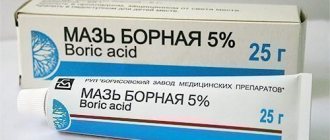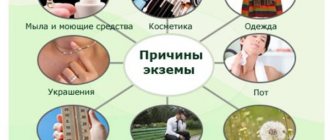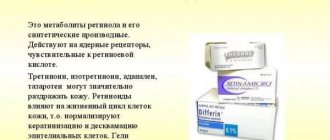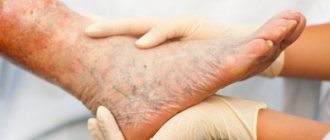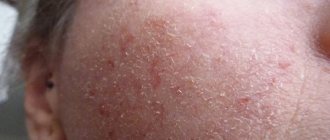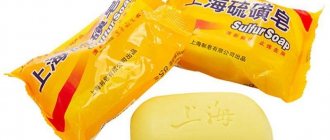Eczema is an inflammatory skin disease of an allergic nature, characterized by a tendency to relapse and appearing in the form of burning, itching and rash on the skin in various places. Patients experience high skin sensitivity to various irritants, which explains the progression of eczema, often burdened by concomitant diseases.
The pathogenesis of the disease is similar to the mechanism of manifestation of allergic dermatitis. Often the latter is a disease that precedes the onset of eczema. The formation of eczema on the leg is one of the most common areas where it is located.
Causes of eczema on the legs
The main reason for the appearance of eczema is a hereditary predisposition to impaired reactivity of the body, as well as to allergization.
The skin of those affected by eczema is usually sensitive to a variety of irritants, both internal and external. Abnormalities in the content of immune cells appear in the blood, as a result of which true eczema is mostly explained by autoimmune diseases .
Endogenous factors that influence the formation of eczema on the legs:
- Pathologies of the endocrine system (diabetes mellitus, hyperthyroidism).
- Long-term infectious diseases.
- Neurogenic (stress, vegetative-vascular dystonia, mental trauma, nervous overstrain).
- Circulatory disorders and vascular diseases (for example, varicose veins, thrombophlebitis).
- Diseases of the intestinal and gastric tract (gastritis, colitis, pancreatitis, cholecystitis, ulcers).
Exogenous factors that lead to the appearance of eczema on the legs or relapse of the disease:
- Wearing wool or synthetic clothing.
- Abrasions, injuries, wounds, scratches.
- The effect of increased or decreased temperatures, climate change.
- Fungus on the feet.
- Exposure to chemical agents, allergens (food, air, contact).
Causes
Currently, eczema is extremely common; according to various sources, it is registered in 10-15% of the total population. There are many types of pathology (read about all types and their features in the article here), one of them is weeping eczema. There are many reasons that can provoke its development.
The development of weeping eczema is based on a malfunction in the immune system, a decrease in the protective function of the skin and its increased sensitivity to aggressive environmental influences.
Predisposing factors include:
p, blockquote 6,0,0,0,0 –>
- Tendency to allergic reactions, accompanying atopic dermatitis, asthma, urticaria, hay fever (seasonal rhinitis).
- Ages from 20 to 50 years - this is the period during which the most active human activity occurs.
- Female gender - they have more frequent contact with household chemicals, cosmetics, and detergents.
- Occupational hazards - most often dishwashers, cleaners, and chemical laboratory workers suffer from pathology.
- Diseases of internal organs (gastrointestinal tract, pancreas, liver, kidneys).
- Endocrine pathologies - diabetes mellitus, thyroid dysfunction, hormonal imbalances in women, including pregnancy, menopause.
- Diseases of the nervous system - neuropathy, neurocirculatory dystonia.
- Immunological disorders - HIV, immunodeficiencies due to taking corticosteroids, cytostatics and other drugs.
- Hypovitaminosis, lack of microelements due to fasting, strict diet, helminthic infestations.
- Hereditary predisposition.
- Intestinal dysbiosis.
- Condition after suffering from infectious diseases (pneumonia, bronchitis, inflammation of the genitourinary system), taking antibacterial agents.
Exacerbation of weeping eczema can be triggered by skin injuries (scratches, abrasions), sunburn, contact with detergents, washing powder, and inappropriate skincare products (hand cream, face cream, gel polish).
Increased anxiety, depression, stress and fatigue negatively affect the immune system and skin and are a trigger for the development of eczema.
Types and photos of eczema
Taking into account the various factors that cause the disease, the following types of eczema on the legs are distinguished:
- Microbial – formed near pyoderma, wounds, foci of inflammation.
- Idiopathic or true. Has a tendency to become a chronic disease. According to external signs, it can be wet and dry.
- Occupational eczema appears in workers in the chemical industry and other areas of production as a result of constant exposure to irritants. It can form on the skin of the legs in the absence of special clothing and protective suits.
- Mycotic – caused by infection of the skin by fungal diseases.
- Horny or callous is formed on the soles of the feet and is a keratinized layer of tissue with inflammation around it.
- Dyshidrotic. Formed on the soles of the feet, it can cause dystrophic changes in the nail plates.
- Varicose eczema often accompanies varicose veins, forming along the infected vessels of the lower extremities.
- Infantile eczema can appear anywhere on the body, usually on the arms and legs.
Nonsteroidal ointments
Eczema on the lower extremities is less treatable than inflammatory processes in other parts of the body. Focal lesions are aggravated by secondary inflammation and external irritation, which are caused by close contact with clothing and other factors. The use of non-hormonal ointments ensures tissue restoration in the following cases:
- with a short-term appearance of a rash in the initial stage of the disease;
- with pronounced skin changes during a long (chronic) course of the disease.
The components that are part of non-hormonal dosage forms do not have dangerous side effects. In addition to the therapeutic effects, non-steroidal ointments and creams allow you to restore the normal functional state of the skin and prolong periods of remission.
Salicylic ointment 2%
One of the most frequently prescribed ointments, which is used in the presence of dry and exudative eczematous processes in the lower extremities, is Salicylic ointment 2% (average cost 25 g/25 rubles). The main active ingredient in the composition is salicylic acid, which has the following properties:
- suppresses endogenous and infectious inflammation in idiopathic, occupational, dyshidrotic and microbial eczema;
- cleanses purulent wounds from serous contents;
- enhances tissue regeneration.
Dry eczema, especially its dyshidrotic form, is localized on the legs and arms. This type of disease is often accompanied by the formation of hyperkeratotic seals on the soles and tops of the feet, and also affects the nail plates. The keratolytic effect promotes the dissolution of keratinized tissue, which facilitates the penetration of the active component to the source of inflammation. Regeneration of the skin occurs as a result of the keratoplastic properties of Salicylic ointment, which accelerate the formation of the horny epidermis.
Zinc ointment
Weeping eczema is characterized by the formation of exudative morphological elements. The wet rash progresses into serous wells, in which purulent contents accumulate, cracks appear on the feet with the flow of serous fluid. For this form of the disease, Zinc ointment is used, which has the following effects:
- suppresses inflammation;
- reduces the flow of fluid into the affected area;
- forms a protective coating on wet fabrics, preventing the effects of external irritants.
The structure of this product allows the contents of erosive wounds to be absorbed, which can then be removed using a gauze swab. The average cost of 30 g of ointment is 25 rubles.
Antifungal ointment Terbinafine
Mycotic eczematous processes are caused by fungal infections, which most often affect the stratum corneum of the feet and the nail plates of the toes. Fungi actively multiply, affecting increasingly large areas and destroying the structure of the skin. Terbinafine 1% (cost 15 g/100 rubles) allows you to suppress the growth and reproduction of fungi, promoting independent tissue regeneration.
Mycotic eczema, localized on the nail plates of the fingers, is better known as nail fungus.
Application of Terbinafine to the affected areas of the skin or nail triggers the death of fungal infections.
The fungicidal properties of the cream have a cumulative effect and appear after the accumulation of the active substance in damaged tissues. Low absorption of the main component is compensated by course application of the product.
Apilak ointment
The legs are constantly exposed to high loads, as a result of which blood supply and tissue trophism deteriorate. This condition is a prerequisite for the occurrence of eczema and makes it difficult for the epidermis to renew itself. Apilak ointment contains bee venom and royal jelly, which have the following effects:
- moisturizing and nourishing flaky dermis;
- stimulation of metabolic processes;
- skin regeneration;
- relief of inflammation in superficial tissues.
Apilak is a protective agent for topical application that can be used for prophylaxis during remission. The drug is affordable - the cost of 50 g is 200 rubles.
D-Panthenol (Bepanten)
An important point in the treatment of eczema is the regeneration and maintenance of the skin. D-Panthenol ointment (25 g/160 rubles) is a powerful regenerator and is aimed at restoring skin damaged by morphological elements.
The physical properties of the drug allow it to be used on rough skin of the legs - the ointment penetrates all layers of the skin, quickly healing the wound surface, and also softens keratinized scar tissue. D-Panthenol has virtually no contraindications and is approved for use in pregnant and lactating women.
Symptoms of the disease
The appearance of any type of eczema is similar in basic external signs . The most common type of eczema is true.
The disease has an abrupt onset with acute symptoms, then it gradually becomes a chronic disease. Against the background of redness and swelling of the skin, small vesicles filled with clear liquid appear. As the eczema progresses, the blisters open, creating local erosive depressions. At this phase, this disease is called “weeping” eczema, since the contents of the vesicles slowly leak onto the skin.
As the body's defense response to this irritant increases, the vesicles dry out , forming crusts. At this stage, the skin becomes dry and severe peeling occurs. The skin on the legs begins to crack, with scabs and scales clearly visible between the cracks. Any degree of formation may be accompanied by redness of the skin, swelling, and severe itching. The place where eczema appears on the legs is mainly the area under the knees, feet, and upper legs. The outlines of the neoplasms are uneven. Infected areas of the skin may alternate with healthy ones.
During dyshidrotic eczema, the vesicles are inflamed and dense; due to the stratum corneum that covers the rash, there are no weeping processes.
Varicose and microbial eczema form near wounds and other skin lesions, resulting in skin redness, itching, severe swelling, as well as the appearance of lamellar crusts, ulcers and papules.
Classification
Depending on the duration of the disease, there is an acute form of weeping eczema and a chronic form, which occurs with episodes of exacerbation and remission. Based on the nature of the clinical picture, localization and causes of inflammation, several types of pathology are distinguished.
Table - Types of weeping eczema
p, blockquote 17,0,0,0,0 –>
| Disease | Flow |
| True weeping eczema | It manifests itself in the form of acute outbreaks, in which it is not always possible to clearly identify the provoking factor. It is more common in people with allergies, various immune disorders, and gastrointestinal pathologies. It begins with swelling and redness of individual areas of the skin, then nodules with blisters appear, which spontaneously burst and form areas of weeping. As healing progresses, crusts form, thickening of the skin, and pigmentation. |
| Seborrheic | The development of pathology is associated with dysfunction of the sebaceous glands, which can occur in adolescence, with hormonal imbalances. This leads to the appearance of a rash on the head, behind the ears, on the back of the neck, and back. With this form of eczema, the rashes tend to merge and can form “rings” or “garlands”. In places of inflammation, yellowish crusts and greasy scales quickly form |
| Microbial | Most often it develops in people with impaired immunity, with diabetes mellitus. It is localized mainly on the legs, around long-term non-healing scratches, abrasions and erosions on the skin. The rash appears along the edges of the wound surface and quickly spreads to neighboring areas. Accompanied by severe itching, painful sensations, the formation of purulent foci, general malaise and fever |
| Professional | It is diagnosed in people who, in their professional activities, are forced to come into contact with various physical and chemical irritants. Develops on the hands of cleaners, laboratory assistants, construction workers, on the faces of actors, models (due to frequent use of makeup) |
| Eczematous cheilitis (eczema on the lips) | Inflammation is localized along the border of the lips; small cracks, crusts, and scales often appear. Wetting with this type of eczema is minimal. Cheilitis most often develops with food allergies, hypovitaminosis |
Weeping eczema on hands
Palms, hands and forearms are the favorite localization of weeping eczema. Most often, the disease is provoked by the use of low-quality or allergenic cosmetics, contact with household chemicals (floor and dishwashing detergents, washing powders), the use of disinfectants, and constant wearing of latex gloves (common among medical personnel and service workers).
In summer, eczema can be triggered by excessive tanning, and in winter - by cold and tight synthetic mittens.
On the hands, weeping eczema begins with redness and swelling of the skin on the fingers and palms. After a few days, itchy blistering rashes appear on the body. The discomfort is so strong that without proper treatment it becomes the cause of insomnia and neuroses, and the inability to perform everyday functions.
The rash on the forearms is prone to rapid spread, the appearance of erosions, crusts and weeping, and peeling. As healing progresses, areas of dark brown pigmentation and dryness remain on the skin.
Stages of development
There are six stages of eczema:
- Papulovesicular – formation of a rash (vesicles, papules).
- Acute or erythematous - erythema and the appearance of edema.
- Weeping - opening of vesicles, pronounced moisture.
- Cortical – drying of bubbles, appearance of scabs.
- Subacute – subsidence of inflammation, dry skin, appearance of cracks and scales.
- Chronic – the skin at the sites of eczema infection remains pigmented, dry, and swollen.
Nutrition for weeping eczema
A hypoallergenic diet is one of the important components of therapy for skin diseases. By normalizing your diet, you can quickly eliminate the unpleasant symptoms of the disease, avoid exacerbations, and prevent complications and chronicity of the pathology.
If signs of weeping eczema appear, it is important to avoid food allergens:
p, blockquote 74,0,0,0,0 –>
- Strawberries, raspberries, currants and other red berries.
- Citrus and exotic (pineapple, mango, banana) fruits.
- Brightly colored vegetables (tomatoes, bell peppers).
- Sea fish and seafood (shrimp, squid, etc.).
- Eggs, cow's milk.
- Honey, nuts, cocoa, chocolate.
It is important to limit the consumption of fatty, fried foods, smoked foods, pickled foods, spices and sauces. It is recommended to completely exclude sweet carbonated drinks, confectionery, alcohol from the diet, and stop smoking.
The basis of nutrition should be greens, fresh vegetables (cucumbers, cabbage), cereals (oatmeal, buckwheat, rice, wheat), pasta, lean meat (poultry, rabbit, veal). All products should be prepared in a gentle way - boiling, stewing, baking in the oven or steaming.
For sweets, you can eat natural marshmallows, marshmallows, biscuits, crackers without additives, dried bread, baked apples and pears. The list of drinks allowed for weeping eczema includes compote of dried fruits and apples, herbal teas, and rose hip decoction.
Complications and consequences
With proper treatment, eczema on the legs does not leave scars or scars . In the chronic stage, external manifestations of the disease can be severe dryness of the skin, cyanosis and swelling.
Complications that can cause harm to health, as well as be a threat to life, are considered to be fungal, viral and bacterial infections that infect the inflamed area as a result of improper care or scratching.
In this case, purulent weeping formations with an unpleasant odor may appear on the skin surface, deterioration in health, headaches, and an increase in body temperature.
The most dangerous complication that can result from eczema is erythroderma . Requires hospital treatment, can affect large areas of the body and is a generalized process. Another disease that is a likely complication of eczema and requires urgent treatment is Koposi’s eczema herpetiformis.
The effectiveness of ointments for eczema
The therapeutic effect of external medications against eczematous processes on the lower extremities depends on the nature and depth of local morphological elements. Serous and exudative rashes, complicated by the development of secondary infectious inflammation, require longer use of ointments or the use of additional drugs.
Since the skin on the legs has a stratum corneum, treatment requires preliminary softening (baths, poultices). The effectiveness of local drugs is much higher for a child than for an adult patient, since in childhood there is no pronounced keratinization of the skin.
Share with your friends
Do something useful, it won't take much time
Diagnosis of the disease
The diagnosis by an allergist or dermatologist is based on identifying factors that provoke eczema and an external examination of the patient.
Laboratory diagnostic methods consist of blood tests for immunograms, as well as biochemical and general blood tests.
Additionally, skin tests can be performed to determine allergens, as well as stool examination for helminths . If accompanying diseases are suspected, consultation with other specialists is required.
Differential diagnosis is made with the appearance of scabies, herpes virus infection, dermatitis, and in children the presence of diathesis.
Diagnostics
For any skin irritation that does not go away for a long time, you need to see a dermatologist. Diagnosis of a disease begins with interviewing the patient and studying his outpatient card, in which the doctor tries to find diseases that are potentially related to the patient’s current condition.
The doctor asks questions about the presence of chronic dermatitis in close relatives and ancestors, as well as about the presence of asthma. In this way, a genetic predisposition to eczema is revealed. The doctor must know about the patient’s work and his occupation. Is he currently taking any medications and has he had any skin irritations or illnesses in the past? Have you had any contact with allergens or irritants? Asks about the sleep and wakefulness routine: the well-being of the hormonal and immune system depends on this. That is, the patient’s medical history is carefully collected. Anamnesis is the medical past of the patient, the presence or absence of factors, conditions that contributed to the onset of the disease with which he went to the doctor; in this case eczema.
Based on the medical history and examination of the patient’s body, the specialist uses laboratory and instrumental research methods that will either confirm the diagnosis or identify another. Often dermatitis is a symptom of other diseases, such as helminthic infestations, which at first glance to a layman have nothing to do with the condition of the skin. Depending on the doctor’s decision, the patient will have to submit blood (for general analysis, immunogram and biochemistry), urine, feces, and skin scrapings for laboratory tests.
After studying the results, the dermatologist may refer the patient to another specialist. And if the test results confirm the presence of eczema, then this is his area, and he will prescribe treatment.
Folk remedies
An inexpensive and effective way to treat eczema are ointments prepared from natural ingredients at home. The basic components of such products are plant extracts, among which are:
- coltsfoot flowers;
- dandelion root;
- birch buds and leaves;
- series;
- plantain;
- nettle;
- thousand-headed pyramidal.
These medicinal plants have anti-inflammatory, wound-healing and softening activity, accelerating the process of regeneration of damaged tissues.
Treatment with folk remedies is limited by the condition of the skin - in the presence of purulent wounds, their use is not recommended.
The preparation of the ointment is carried out in two stages:
- Preparation of herbal extract
. Fresh ingredients (50 g of any 5 herbs) are ground through a meat grinder or blender to a paste. The finished mixture is carefully squeezed into an opaque container. - Mixing components
. As a base for the ointment, use regular Vaseline or badger fat. 100 g of base is added to the herbal extract and mixed thoroughly until smooth. The finished mass is tightly sealed and stored in the refrigerator for no more than 10 days.
An ointment based on herbal extract is applied to damaged skin in the form of applications, up to 3 times a day. If the stratum corneum is very dense and dry, first make a warm foot bath. The maximum course is 14 days, further treatment is performed after a break. It is recommended to use self-prepared ointments in combination with pharmaceutical preparations.
Affordable and effective means
In the treatment of eczema localized on the lower extremities, several types of external agents are used. The table shows the types of pharmaceutical drugs (the most accessible and inexpensive dosage forms) and their therapeutic effects.
| NS Group | Types of NS | Drug name | pharmachologic effect |
| Non-hormonal ointments | antibiotics and antimicrobials | Salicylic ointment | antiexudative antimicrobial regenerative analgesic antiseptic dermatotropic |
| Zinc ointment | |||
| antimycotics | Terbinafine | fungicidal fungistatic | |
| tread | Apilak | dermatotropic regenerative softening moisturizing nourishing antipruritic | |
| D-Panthenol | |||
| Hormonal ointments | topical glucocorticosteroids | Hydrocortisone | anti-inflammatory antipruritic anti-edematous analgesic |
| Prednisolone ointment | |||
| Sinaflan |
Non-hormonal ointments are used to treat all forms of eczema and as supportive agents. Topical steroids are used in cases where inflammation becomes acute or the morphological elements of the rash cannot be cured with non-steroidal ointments.
Properties of ointments
External remedies for eczema are represented by ointments, creams, gels and liniments. They contain active medicinal substances with the following properties:
Ointments and creams are made on the basis of soft components that are easily and evenly distributed over the surface of the skin. This property allows you to successfully treat extensive lesions without causing additional damage.
Drug treatment
Eczema is a disease of an allergic nature; taking antihistamines is an important part of treatment. Modern drugs of the second or third generation are used more often, sometimes 1st generation - depending on the resistance of the patient. It is better to administer medications intravenously. To eliminate intoxication, sorbents (enterosgel, polysorb, activated carbon) are prescribed orally, and hemodez is administered intravenously.
For eczema, desensitizing drugs are prescribed to reduce the allergic reaction. These agents include calcium gluconate and calcium chloride. A solution of 5-10 ml of calcium chloride in 100-200 ml of saline is administered intravenously. Calcium chloride must not be administered intramuscularly - such an injection can lead to abscess and necrosis of the muscle at the injection site. Calcium gluconate is administered intravenously or taken orally in tablets. Hexamine and sodium thiosulfate have a similar effect.
Anti-inflammatory drugs are prescribed, for example, corticosteroids, and are used for severe or long-term disease when other drugs do not help. These drugs include prednisolone and dexamethasone. In mild cases, non-steroidal anti-inflammatory drugs are used:
- nimesulide;
- ibuprofen;
- meloxicam;
- diclofenac.
If an infection occurs, antibiotics are prescribed. In severe cases, cytostatics that suppress the reaction of the immune system and diuretics (diuretics) are used. To correct the functioning of the immune system, immunomodulators are prescribed: cycloferon, polyoxidonium, sodium nucleinate, a combination of vitamins A and E, aloe extracts, echinacea, and vitamins B, A, E, C as a general tonic.
Purpose of treatment
When treating weeping eczema, a systematic approach is important. While reducing skin manifestations, it is important to tidy up the digestive system. Therefore, enzymes are prescribed (festal, pancreatin, mezim). Taking enzyme preparations continues for several months. For dysbacteriosis, Bifiform, Linex, and Hilak Forte are recommended. Fermented milk products improve the functioning of the gastrointestinal tract.
Stress can cause eczema or worsen the patient’s condition; sedatives and antidepressants are often prescribed for weeping eczema. Non-addictive herbal preparations based on valerian, St. John's wort and plants that have a sedative effect are preferred.
Eczema requires complex treatment. The doctor chooses the most suitable ones for a particular case.
Antiseptic lotions are prescribed locally:
- 2% boric acid solution;
- 2% tannin;
- silver nitrate;
- potassium permanganate;
- soda;
- dimexide;
- resorcinol.
When crusts form in place of wet areas, use zinc, ichthyol paste, moistened lotions with tar, and boric acid solution. Hormonal ointments containing corticosteroids (Elocom, Advantan, Lokoid), combination agents (Triderm), ointments with topical calcineurin inhibitors (Pimecrolimus, Protopic), which reduce itching and irritation, are used. To soften the skin, salicylic, boric ointment, creams with ketoconazole, and Lorinden-S are used. Castellani liquid and aniline dyes are used to lubricate the crusts.
Castellani Liquid
